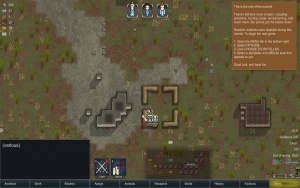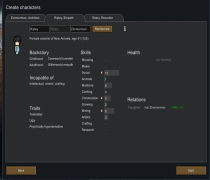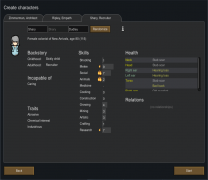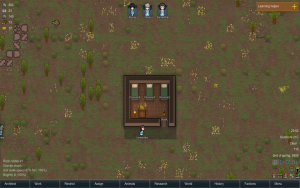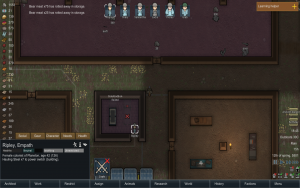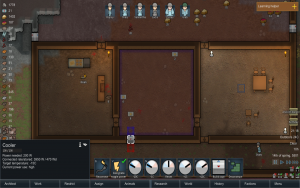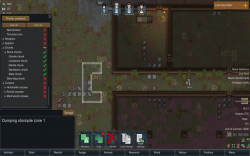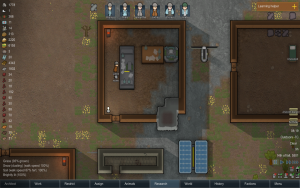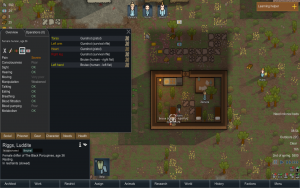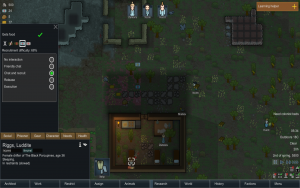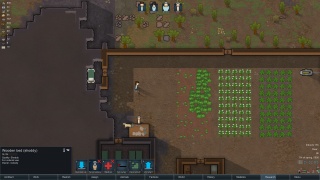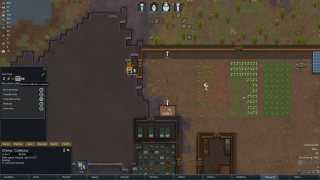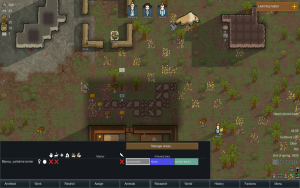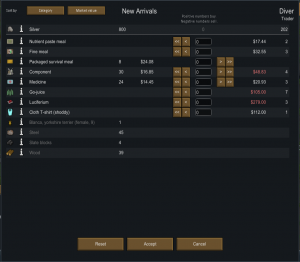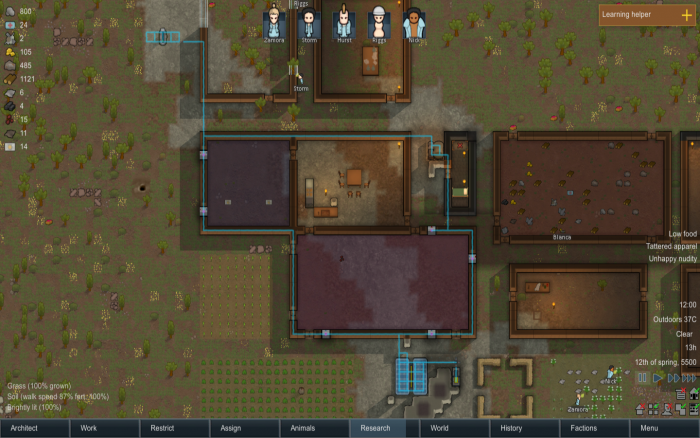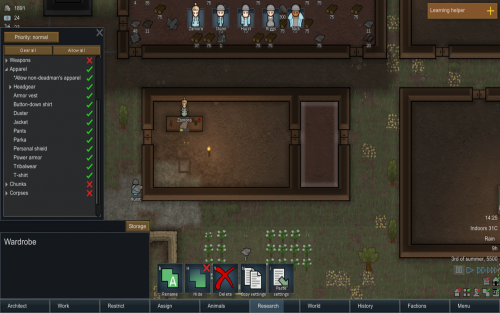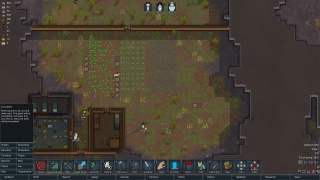Basics
|
Tutorial
The tutorial teaches the basics by highlights including: game set up, short walkthrough about building a small colony and defeating the first raider. At the end, the player can continue the same game after choosing a storyteller. This feature was added in Alpha 16 version.
While the tutorial mode teaches you the basics, this article provides more insight while still not getting into depth.
The basics
This page excludes content addressed elsewhere such as Game creation, Scenario system, AI Storytellers, World generation and Biomes. Instead, it focusing on basic topics like: Prisoners, hunting, trade, animal taming and much more.
This page also assumes you play using the original Crashlanded scenario. If you intend on playing other default scenarios, you may want to check the other guides.
New colony
For your first time playing it is strongly suggested that you:
- Pick the standard Crashlanded scenario since it is to what most tutorials/information are geared towards.
- Select the storyteller Cassandra Classic or Phoebe Chillax on Base Builder difficulty.
- Alternatively, you may pick Peaceful but you may lose out on learning how to deal with major threats.
- Pick your landing site by clicking on the generated map.
- For biomes, choose Temperate Forest or Arid Shrubland, this will give you a comfortable location to learn the game and food will not be a factor unless during events.
- For climate, choose an area where the growing season is 'Year-round', that way you can grow crops year-round, and the temperature never falls low enough to become a threat.
- For terrain, choose Flat or Small Hills, this gives you enough area to expand later on.
Colonist Selection
You will start with three colonists, picks are randomized and cannot be fully customized by the player`s will. There are a few aspects worth taking into consideration:
- Look into their inabilities:
- Colonists who are incapable of violence, will not be able to fight incoming threats.
- Colonists who are incapable of dumb labor will not willingly haul, clean or cut plants.
- Look into their traits. Some are extremely toxic:
- Abrasive will tend to insult others and start fights.
- Chemical interest/fascination will often go on drug binges.
- Volatile colonists go into mental breaks very easily.
- Pyromaniacs will start fires randomly, doing so more often when stressed.
- Some other traits are not as bad but are still worth watching out:
- Prosthophobes will reject any form of bionic enhancement.
- Some traits bring both benefit and harm:
- Trigger-happy colonists fire faster but are less accurate.
- Neurotic colonists work faster but also more prone to breakdown.
- Watch their health conditions.
- Older characters are more prone to chronic conditions, gain immunity slower (meaning higher chance of death by illness) can randomly have heart attacks.
- Asthmatic characters will require constant medical attention.
- Drug addicts require drugs to keep them in check, or will lapse into withdrawal.
- Artery blockage means you have a deadline to get a replacement heart for that colonist before their heart stops working and they die.
Aim to get all three colonists who combined are incapable of none. Additionally, at least one colonist should be proficient in the following skills (you are aiming for 5+ skills with passion, max is 20):
- Social - Recruiting new colonists and improving trade deals
- Medicine - Healing the colonists you have
- Cooking - Making food
- Construction - Building
- Growing - Growing/harvesting food
- Mining - Hollowing out mountains/hills and mining for mineral resources
- Crafting - Creating clothing, weapons and other trade goods
- Research - Advancing your technology
Additionally, characters have Passions which are represented by fire icons (single and double) meaning that will learn such skill faster. Colonists with one flame learn the skill at 100% speed, while those with two learn it at 150%.
But do not worry too much about traits as characters will evolve within time base on the orders you give to them. And others will be joining soon!
At the beginning
Starter weapons
The tutorial forces the player to assign weapons to colonist randomly without analyzing their character profile. But there are basically two type of fighters: ranged and melee. Giving characters the wrong type of weapon can cause negative mood and at the same time, lose efficiency as a whole. So please, sort compatibility.
Take the one with the highest melee skill and give the knife, the best shot should be given the survival rifle and the remaining colonist the pistol. Give every colonist a weapon even if that means giving a brawler a ranged weapon, you can make them a shiv later but everybody should be armed.
Making a home
In the tutorial you are taught to build your early home at the center of the map, to fasten the lecture. This makes sense since its around the area where the starter items dropped, building home too far away will increase the travel distance from pick-up point to blueprint area. Still, look around near to where you land, any pre-constructed structures will speed your set up (just fill in the gaps). And don't forget to place an animal sleeping spot indoors as well, if they sleep outdoors they run the risk of predator attack and exposure to dangerous weather.
Work
Colonists will have default settings and for a while you will see them "occupied", however soon you will notice that some are just "wandering" around or complete idle. This is because there's need of adjustments within their tasks.
To improve their cooperation, open the Work tab at the bottom. Tick green on each character when possible to give them additional tasks or free them from others, colonists will prioritize from left to right as indicated. However this system is somehow precaic. Toggle to "Manual priorities" by clicking the red cross for the green tick.
This will give you 5 degrees of priority for each task: 1 (higher) - 4 (lower) + unassigned.
Example behavior:
- Samantha will proceed by: Patient, Doctor, Bed rest, Warden, Cook, Research then follow by Construct, Grow continue with Smith, Tailor, Craft and finally Hunt. This is so long as once a task is completed, there isn't any other with tiger priority in need of taking care. This means that if the player sees her growing crops and more blueprints are laid, but at the same time there`s a cooking bill; she will cook first before constructing.
This is because all tasks are weighted left to right, even while marking everything with 1. You break the priority assignment with different values. A colonist will look at all level 1 tasks, left to right, to see if any need accomplishing. If the colonist cannot find a level 1 task that needs accomplishing, he/she will move onto any level 2 tasks, then 3, then 4. They will never work on any task that is unnumbered.
While setting up a colonists work priorities there are two visual cues that help give you an idea of this colonists suitability for the task:
- The first is the box outline itself for the number becomes brighter the more proficient a colonist is at the task.
- The second cue, are the small fire marks in the bottom corner of a task box which denote the colonists passion for the task, or how quickly they will learn it. A colonist with no passion learns at 33%, with a single passion at 100%, and with a double passion at 150%. Consider making colonists with low skill but high passions work their preferred task as they will skill up quickly.
Stockpiles
There are two types of stockpiles, the common Stockpile and the Dumping Stockpile. They work similarly but have different uses, the first for wanted goods and the later for unwanted junk.
Since we are starting from the ground, a common stockpile for materials like wood will make building an entire colony faster if the needed resources are already stored at one single place rather scattered around the map. While laying down the blueprints, its faster if at the same time, all trees and bushes are assigned to be chopped, harvested and cut to clear the ground for easier construction while leaving all the wood close by. To ensure this last step, designate already the same space for common stockpile. Have in mind that roofs can extend up to 6 tiles away from a wall (7 including the wall roof itself), any area larger than that will need columns to sustain an extensive roof.
Items left out in the open will deteriorate due to exposure so it is in your best interest to haul them in as soon as possible. Make sure to check what items you want in each storage room by settings accordingly. Later on you can repeat this same process to build other storages exclusive for weapons and armor, raw materials, trade goods, etc. You can also rename each area by clicking the highlight on the ground.
The dumping stockpile is not crucial at the beginning and it's better to spend the first days with other aspects of the game that are more pressing matters.
Harvest and Plantation
After settling a temporal home, the next concern is food. You will need two things: the food itself and a storage. Everything within the proximities, select the order to harvest and drag the mouse to assign an area for search, the game will automatically task grown bushes with fruits to collect their berries. This is just to ensure easy access on nutrition. Now you must have a place to store the gatherings. Either storage of food or materials will become frequently accessed spots so placing them in the heart of your colony will reduce hauling distance and speed.
The food storage may need expansion later on so leave one of its side areas free for the future. Ideally it is convenient if the storage is attached to your future kitchen, so building a next room for the fueled stove and butcher table is wise. As well as using another side of the storage for the dinning room where you can place tables and chairs.
With the storage free of space and a kitchen ready to cook, now its a good time to start building farms. There are three basic foods you can plant: rice, potatoes and corn. Rice grows quickly but is nutrient weak, corn grows slowly but is nutrient dense; and potatoes are the middle ground. You may as well plant cotton for clothing and, if you have a colonist with farming skill at 8 or above, you should also start growing healroot. It is the early variant of medicine that your colonists can use to heal each other.
When selecting locations to build your farms, consider proximity to the food storage for convenience.
Building a Freezer
You may have or not noticed by now a notification message at the top saying "X" food has rotted away in storage.
This is because food needs to be refrigerated. To upgrade your colony, you will need access to power to produce Electricity and build coolers. There`s a variety of original ideas when designing power grid planning, but basically constructing these devices require components that can be mined, traded, manufactured and salvaged from ship chunks. In early game, you may have limited supplies so treat them as delicate devices. This means, do not place them on your outline leaving them exposed to attack, watch for fire alarms and stop shooting in their direction.
The power source be it Fueled generator, Solar generator or Wind turbine, they all poses their pros and cons, but must be connected via Power conduits to the Coolers themselves. The coolers have directions, blue indicates cold and red means heat, so make sure you rotate blue towards the inside. Once you have done that, next is the device set up.
The default temperature is always 21 Celsius and that won't help, use the buttons to adjust. The cooler will attempt to reach your designated value, but it all depends in details such as not leaving unroofed areas and the room size itself. Sometimes one cooler alone is not enough. So always hoover your mouse to check if the desired temperature has been achieved. In winter you can also completely turn coolers off and in extreme summers you may need to build additional units.
Joy
If you are coming from the Tutorial, you will already have your horseshoe pin, if not, build one and that will clear the notification list on the right. Joy counters stress and as you progress through the rise of your colony continue upgrading their entertainment by adding other items such as chess table (with dinning chairs) and billiards table. Note that joy is also performed by other actions that do not require you to construct anything, see activities.
When you construct a horseshoes pin, place it somewhere you can keep watch so as to not risk a surprise attack. Later on, with more colonists and resources, you can move it inside to make a rec room.
Basic Defense
The game will prompt the notification of "Need defenses" early on, probably at the same time you are still building the basic rooms (storage, kitchen, dinning room, quarters) while still haven't started cutting stones. So you would be counting on wood and steel mainly. If you just want to turn off the message, setting up sandbags will do. Pause the game and take a wide large view of the entire map. It will be unlikely to have enemies arrive through mountains or sea and large forest areas abundant of trees will slow down any intruder. Watch taking into account your colony`s rooms plan to find vulnerable areas and construct your first sandbags. You don`t need to make a 25 tiles line, steel doesn't come as easy as wood.
There are two other cheap alternatives for early game stage that are walls and an imitation of wall made of chunks placed next to each other by designing a dumping stockpile with the shape of a base defense. Must set the priority to at least Preferred, this way, designated chunks will be hauled to your defenses first before placed into your general dumping stockpile zone. It`s easier to build walls between mountains as they serve as choke points.
Place deadfall traps in locations where hostiles would most likely come by intentionally creating bottle neck corridors as well.
- In the future, if you do happen to get attacked, it`s best if you don`t kill the hostile so that you can make him/her a prisoner for sale as slave or recruit for your colony. Once the enemy has been weakened sufficiently, continue your self-defense with fists or blunt weapons only to maximize chance of downing rather than killing.
Research
- If coming from the Tutorial, you already have a Research bench placed within the barracks and next to the Fueled stove.
- If you skipped the Tutorial and started right away, its best if you can place beds, build the kitchen and the research lab, all three in different rooms. Beds can be reinstalled elsewhere but not the fueled stove or the desk.
Raids
- If coming from the Tutorial, you already faced this threat.
- If playing without the Tutorial...
It will not take long for your first raid. Typically it is a single individual armed with a melee weapon. He may or may not immediately attack. Draft your men behind cover, be it chunks, trees, walls or sandbags and make sure they are next to each other by positioning them with multi-selection (see Friendly fire safe in the in game help).
As it was mentioned earlier in the above section, you're lucky if you downed the hostile without killing him/her as you can make a prisoner and recruit, sell or harvest organs if you are willing to. If he/she is still alive, quickly convert your barrack or other spare rooms if available to a Prison and choose Capture on the intruder. If needed, immediately heal wounds by prioritizing a doctor.
If the hostile died, either:
- Bury in a grave by making a cemetery.
- Place in a dumping stockpile (away from your base to prevent mood debuffs).
- Eat them (mood + relation penalty for non-cannibals).
- Use them for animal feed.
Doctoring
If a colonist is injured or sick, doctors will treat them.
On the patient's Health tab, overview you will be able to choose which type of medical care will be provided, there are 5 options: No Care, Doctor Care, Herbal Medicine, Normal Medicine or Best Quality.
When the need to combat comes, if possible, try not to take the most skillful doctor to battle as you may end up with no one able to treat the wounded afterwards.
Spare Room
- If coming from the Tutorial like written just above, you had to convert your barracks into an improvised infirmary. You can now choose to either build private rooms for each colonist or just a single room to turn into Prison or Hospital for the recently captured/rescued.
- If playing a normal new game, the timing of your first incoming raid will vary and you may as well get an Escape pod event beforehand.
There are many occurrences that can threaten your colony, be it accidents, illnesses, manhunter packs, etc. And by the time a negative incident takes place, it might be too late to start building up an emergency room. So its wise to construct a spare room with beds which can be switched to either Hospital or Prison. If time and resources allow, having medical supplies nearby may mean the difference between life and death for the patient. If possible, ensure the surrounding area has a clear free path towards the room without much obstacles in the way. Like mentioned earlier, this facility located at the heart of the colony may be a good choice too as incidents can take place at map corners and having to rush across the entire land while bleeding may prove fatal.
New colony members
Your character roster can increase in many ways.
- Capturing prisoners: As mentioned, if you already performed the first steps, capturing alone does not mean that person will join you right away after he/she has healed. You will have to recruit that pawn. In order to accomplish that, you will need to send someone to talk to that person and convince him/her to join, it may take several attempts. It will be easier if the wanted pawn receives proper medical care, is fed, feels as comfortable and happy as possible, and you use your best wardens to recruit them.
- You can also try to take downed friendlies but this will cause the faction to turn hostile. If you care about relations it's best that you rescue them instead, this gives a +15 relations boost for every rescued person.
- Slave purchase: Slaves are easier as you won`t need to recruit them, they will join you immediately... after purchase from pirate merchants, which ain't cheap...
- Wanderer joins: This one is the luckiest you can get. A stranger will just join without need of recruit or purchase.
- Chased refugee: A refugee seeks shelter and safety at the colony in return for joining it. Like the Wanderer Joins event, colonists joining this way immediately become available to the colony. However, no sooner than the new colonist get settled will a raid immediately follow up. You will have to fight off the incoming raid, possibly putting more colonists at risk, but at the same time gives the opportunity to capture more prisoners. You can see the kind of person they are (i.e. adult backstory, or child if under 20), and reject the offer if you know the colonist is not much use or you can't risk a raid.
- Escape pod survivor: As mentioned, this one will mean that you have to rush someone for rescue. The main difference between crash-landed characters like yours and escape pod survivors is that you arrived intact, will in this case, the pawn will arrive unconscious and critically hurt.
The gallery above was edited so text can be read as you hover your mouse pointer over the pictures.
Basically, the main difference between a raid capture and an escape pod survivor, is that the later one falls elsewhere while the raider comes towards you, "healthy" at first. Note that in this example, instead of building a whole new room, if you happen to have a mountain nearby, caving in saves work to do.
Careful when you assign a rusher to get the escape pod survivor as selecting "Rescue" has a chance that the survivor does not join, instead leaving the map once his injuries are healed. This is more likely to happen when you have more colonists. If they join, however, they do so immediately without needing to go through recruitment. If the pawn is not of your liking, just let go. But if you intend to keep them, then you must Capture, which means double the work for you to do that could have been simplified if Captured at first action.
Capturing also has the advantage of allowing wardens to practice social; if you don't want them to recruit the survivor simply set Interaction to 'Friendly chat', and let them go when you are satisfied with the results.
Animals
Either from the Tutorial or a new game in Crashlanded, you will be starting with an already tamed animal. In the main Animal tab, you will see their training selection, who interacts with and their zones. You need to turn the red crosses into green ticks so that the characters assigned to Handle will teach them valuable skills such as Rescue and Haul. Then the zones you assign them to wander around are important. Depending on the type of animal you get, some can handle themselves in the wild while other are better taken care of at home.
You can keep expanding your roster by taming more species or trading with Bulk Goods Traders, they come in with already tamed and ready to train animals.
Predators may be roaming nearby, these mid-large size carnivorous animals will not pose any immediate threat and its best to just let them be, unless of course, you or your pets get attacked. So always keep watch of your surroundings and their proximity range. Their "Needs" tab will show a Food meter, and if you see them getting empty, that's when they will be likely to go for prey.
Trading
Soon you will be visited by other Factions. Once they arrive to your colony, pick the colonist with the highest Social skill you have among your members and send him/her to open trade by right clicking the one with the '?' sign above their head.
Power
Since we already start with knowledge of Electricity, access to power is available so long as theres abundance in materials required, steel and components.
- Fueled generator requires wood and refueling on regular basis (make sure to roof).
- Solar panel produces energy with sunlight.
- Wind turbine provides energy so long as there`s wind blowing. Requires adequate clear space to run properly. No trees, walls, mountains, etc in their way. They can go over solar panels and fields though, so you can tightly pack three solar panels under a wind turbine if you chose.
- Geothermal generator, available later in game generates through steam and must be placed Both require batteries to ensure 100% uptime.
- Batteries store energy when there`s shortage (make sure to roof). Batteries run malfunction danger due to short circuits unless isolated by a power switch.
All these devices must be connected through power conduits to the electronics you wish to run.
Personal Quarters
Barracks can give your colonists a heavy mood debuff; in addition to the Shared Bedroom debuff with a -5 mood penalty, they also get the Disturbed Sleep debuff, which stacks up to 4 times to give a -6 penalty. Thus, if you have a good colony up and running, and taken care of everything else, you should think about giving your colonist their own bedroom.
Even an awful bedroom is better than all but the most deluxe barracks, and also makes it harder for you colonists' sleep to be interrupted.
Cleaning
After a while, you may find that dirt is starting to build up all over your colony. Having dirt in a room makes it look ugly, giving your colonists a mood debuff. If you need to do surgery, it also makes it more likely to fail.
Rooms with high traffic, such as your barracks, are more likely to be dirty. Hospitals are also very easily soiled as your colonists bleed out all over the floor while your doctors try desperately to save them.
Though it seems like a rather low-priority job, you should still have someone to clean up your colony occasionally.
Intermediate Early Stage
This means that by now you have:
- Food stored to at least feed your colonist during winter when crops do not grow.
- Each colonist have their own room.
- You built a kitchen with dinning room (tables and chairs).
- You got to a point where life threat is external rather internal.
Basic Defense
For a more in-depth guide see Defense tactics.
Always consider your defenses BEFORE you need them. Nothing is instant in Rimworld, so trying to scramble something last minute will be difficult, if you aren't dead already from lack of preparation.
Simple Wall
In the easiest difficulties games, such as Peaceful, raids will be mostly single enemies attacking your colony. To the point that they do not become a considerable threat. For instance, predators attacks are more dangerous than raiders because the first have the "surprise" element while incoming rival factions come to invade with "announcement" (you get a red envelope message to the right of the screen), so you have some minimal time to prepare yourself, at least positioning.
What needs to be understood about Defenses is that enemies will not bust open your doors but infiltrate from wall openings. So its easy to trick the hostile AI pawns by laying Deadfall traps where areas walls are not built (either because it wasn't worth it or you just can't rise them over water).
It`s easier to build walls by filling in the gaps between mountain and old ruins. Walls will be of better use to protect your plantations from herbivorous animals and any other locations where your pawns tend to walk around oftenly by the limits of your colony to avoid said predator attacks.
Make sure you clear your Home zone (the blue one) so that pawns do not go beyond the wall by selecting Architect > Zone/Area > Clear allowed area > Home.
Training your fighters
Hopefully you didn't had the need to survive winter by hunting only due to lack of berries or crops. Assuming you already manage to somehow settle, by now you should be with your first three starter characters and maybe some more who joined you along the course of time, still most likely your colony will be rather a militia than an army.
If you didn't realize yet, characters can progress their skills except for those who are incapable of at certain categories. It`s best if those who can Hunt, can be trained to reach at least level 10, same for melee fighters as well. What counts towards their learning is "practice", which means to let your pawns to shoot many times or swing their weapons many times. For shooters, the smaller the target, the harder to hit. Which is wise and convenient, since your colony is still small, untrained and maybe you leave someone good in Doctoring behind to tend the wounded later, it would be too dangerous to risk your men against large animals that could leave your people with permanent health problems.
Friendly fire safety tactic, as taught at the "learning helper" on the top right of the screen is a good start, basically your ranged characters will be shooting over the shoulders of their melee friends who will be guarding them when hostiles reach their position. But of course, melee characters don`t need to wait until enraged animals get close. After shooters have "downed" a target, instead of making the shooters to keep firing, just order the melee to finish them, and practice more swinging. Remember to tell the shooters to stop firing.
Don`t waste your practiced target (unforbid their corpses), and deliver them to your butcher to take as much as possible meat and fur from them.
Hunting
You may need meat for food or fur for apparels. Consider you current situation and pick a target accordingly. Don`t go against a Thrumbo with just 3 dudes. While of course, the smaller the target the little gain, it`s still best to play it safe.
When you select animals to be hunted, this means that the game will assign just one pawn to go after it and considering your character may very well still be unskilled, it`s best if more than one can go hunt for the needed items. So instead of just assigning targets to hunt, use the alternative method of "Drafting" many characters and then right click, the Red Cross equals the hunt task.
Once you have captured your prey, you will need a butcher table to process the corpse into edible meat and leather as well. Make sure to get the prey back home, as leaving it there too long may cause it to deteriorate and start rooting at which point its already wasted.
Meat can be cooked into fine meals in conjunction with plant-based foods. They are slightly more nourishing than simple meal and provide +5 mood which is good for lifting colonists' spirits, even well into the mid-game.
Leather provides better protection than cloth and almost the same as synthread, making it a decent replacement for your synthread starter clothes, which can only be obtained through trading.
Apparel
Either Tutorial or Crash-landed scenarios start with characters wearing Synthread gear which is resistant enough to last a year long before deteriorating, so it`s not a high priority. For a pawn assigned to Tailor work swiftly, it`s convenient if both the fabrics storage is somewhat close and with a next room designated to store finished wear. Characters react faster to available clothing if the product is listed in the items column instead of just laying by the bench.
Fire Handling
Fire is a very real threat in Rimworld. The first thing you need to consider, especially building with wood, is how fire will spread through your base.
In this case, mow your lawn.
Go to Architect -> Orders - Cut Plants and select all plants NOT part of your growing zones inside your courtyard. We want to remove all plants from growing inside as it is just kindling in the event of a lightning storm. Note that this will probably take some time and you will probably have to redo it a few times to get all the stragglers. You should also consider mowing a few tiles from your walls on the outside as well if you intend on keeping wood walls for any extended period of time. You can install wooden floors if you want to force no plants to grow there.
In the event you do get a fire there are two ways you can handle it.
- You can let the colonists handle it on their own. They will automatically put out fires inside your home zone (Architect -> Zones -> Home Area) so long as they are prioritized to do so. This can lead to rather haphazard fire fighting though, with colonists all over the place.
- You can draft your colonists and move them adjacent to a fire. While drafted a colonist will fight the fire and you can coordinate your efforts.
Mining
Mining can be ignored at the very beginning of the game. However its still wise to pause the game at the start to take a careful look around the map by checking the borders of each mountain. Metals like Gold, Silver, Steel and Plasteel will turn very useful as well as Jade. While you need just wood to build most of your beginning improvisations, these materials are valuable enough to let you buy items that cannot be crafted by players and are only available from AI traders such as Medicine. You won`t have much currency first so these materials can come very handy. Compacted machinery provide components when mined out.
Click on the the ores and then press on Mine.
Stonecutting
Stone blocks are a superior building material in many ways; it is relatively cheap, easy to obtain and is completely fireproof.
You can make stone blocks out of the many stone chunks lying around (unless you're in a Sea Ice biome; if you're already that far into the game, what're you still doing here?). Each chunk makes 20 blocks, enough for 4 walls.
To start making stone blocks, you need to build a stonecutter's table using steel and another material, preferably wood. You also need a craftsman to cut the chunks into usable blocks.
Building stone structures is a key part of upgrading your base to becoming more durable. It is not essential to survival however, and is best done mid-game. Stone also has its shortcomings; stone structures take ages to build, and stone furniture is less comfortable. Unless you really need your beds or other furniture to be fireproof, build them out of wood instead.
Quality Furniture
See also: Quality
While it gets the job done, your colonists definitely won't be happy with sleeping on an Awful bed for the next of their life as a colonist, or sitting on a chair that feels like it's gonna topple over anytime soon.
By this time you should already have at least 1 decent builder if you didn't mess up character selection. Get them to deconstruct your furniture and build new ones in their place.
Quality furniture has good effects. They provide more beauty, contributing to a better environment that makes colonists feel happier. Having good beds and chairs also make colonists feel more comfortable for those sweet, sweet mood bonuses, and colonists will rest faster in a better bed too.
Decoration
You should also decorate your colony to make your colonists...er...well... who doesn't like happy colonists? They feel happier when their surroundings are more beautiful, or they use a room that feels impressive to them.
Flower pots are a good early-mid game method to decorate your base. Just put them down and a grower will automatically plant flowers into the pot for beauty.
Sculptures are more of a mid-game thing, but require no maintenance at all, except for maybe some repairs when it gets damaged. Simply put/build them where you need them, and the room magically becomes more beautiful.
You will need a sculptor's table in order to start making statues. This is also when your artists, previously useless until now, begin to shine.
Besides this, building better floors also helps. It is completely reckless at any time but late end-game to build silver or gold tiles, however, you can still get a good replacement. Smooth stone floors are just as good as silver tiles, and stone tiles or carpets (when researched) can be placed anywhere while providing a modest boost to beauty.
Other Guides
- Intermediate Midgame Guide - continuing expansion of your base
TODO LIST
- Cleaning Needs pictures and expansion
- Mining Needs pictures and expansion
- Medicine and treatment. -Needs pictures
- Single quarters. -Needs pictures
- Night owls and nudists.
- Hunting -Needs pictures
- Sculpting, flowers and better rooms. -Incomplete, needs pictures and expansion
- Turrets
- Temperature control
- Animal Handling -Needs pictures
